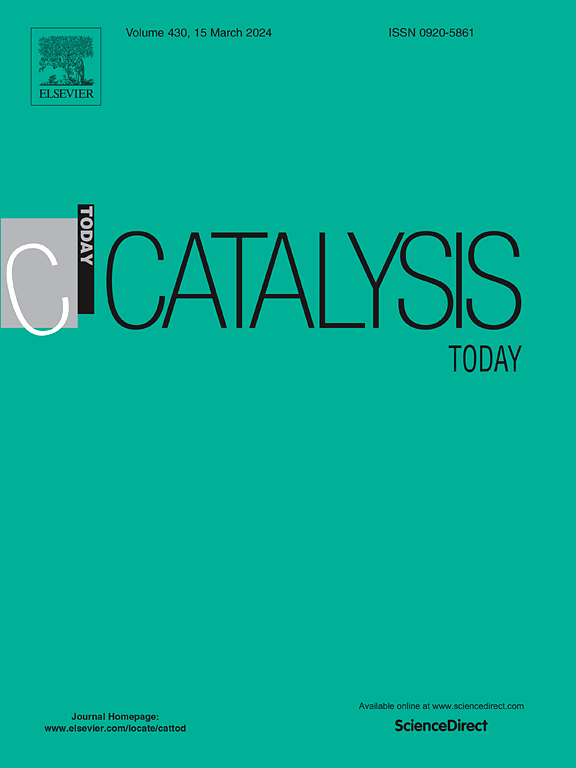Effect of Ce:Ti ratio and cerium salts on the properties of mesoporous Ti-Ce oxides and their photocatalytic activity
IF 5.2
2区 化学
Q1 CHEMISTRY, APPLIED
引用次数: 0
Abstract
To investigate the influence of different CeO2 precursors and Ce:Ti ratios, we have synthesised 8 mesoporous Ti-Ce oxides via the evaporation-induced self-assembly (EISA) method with Ce:Ti ratios between 0.2 and 20 mol%. The materials exhibited type IV isotherms and a specific surface area of 140–180 m2·g−1 with pore diameters in range of 3–20 nm. The crystalline phases of materials comprised predominantly anatase with a significant decrease in overall crystalline content with increasing Ce:Ti ratio. Materials with higher Ce:Ti ratio showed an increased light absorption in the visible region. Although crystalline CeO2 was not detected, the presence of Ce(IV) was confirmed by X-ray photoelectron spectroscopy. For the photocatalytic experiments, we compared these materials with the TiO2-CeO2 composites of our previously published syntheses to yield 16 samples synthesized via three synthesis approaches: (1) concurrent synthesis from titanium alkoxide and cerium salts in one pot, (2) synthesis of TiO2 in the presence of previously-synthesised CeO2 and (3) physical mixing of separately-synthesised TiO2 and CeO2. Samples produced by physically mixing the separately-synthesised TiO2 and CeO2 showed the best photocatalytic activity towards gaseous isopropanol degradation, while the samples with TiO2 synthesised in the presence of CeO2 showed the best photocatalytic stability.
铈钛比和铈盐对介孔钛铈氧化物性能及光催化活性的影响
为了研究不同CeO2前驱体和Ce:Ti比对其性能的影响,我们采用蒸发诱导自组装(EISA)方法合成了8种介孔Ti-Ce氧化物,Ce:Ti比在0.2 ~ 20 mol%之间。材料表现为IV型等温线,比表面积为140 ~ 180 m2·g−1,孔径为3 ~ 20 nm。随着Ce:Ti比的增加,材料的晶相以锐钛矿为主,总晶含量显著降低。Ce:Ti比高的材料在可见光区域的光吸收增加。虽然没有检测到结晶CeO2,但通过x射线光电子能谱证实了Ce(IV)的存在。在光催化实验中,我们将这些材料与我们之前合成的TiO2-CeO2复合材料进行了比较,得到了16个样品,通过三种合成方法合成:(1)在一个锅中同时合成醇钛和铈盐,(2)在先前合成的CeO2存在下合成TiO2,(3)将单独合成的TiO2和CeO2物理混合。单独合成的TiO2与CeO2物理混合制备的样品对气态异丙醇降解的光催化活性最好,而在CeO2存在下合成的TiO2样品的光催化稳定性最好。
本文章由计算机程序翻译,如有差异,请以英文原文为准。
求助全文
约1分钟内获得全文
求助全文
来源期刊

Catalysis Today
化学-工程:化工
CiteScore
11.50
自引率
3.80%
发文量
573
审稿时长
2.9 months
期刊介绍:
Catalysis Today focuses on the rapid publication of original invited papers devoted to currently important topics in catalysis and related subjects. The journal only publishes special issues (Proposing a Catalysis Today Special Issue), each of which is supervised by Guest Editors who recruit individual papers and oversee the peer review process. Catalysis Today offers researchers in the field of catalysis in-depth overviews of topical issues.
Both fundamental and applied aspects of catalysis are covered. Subjects such as catalysis of immobilized organometallic and biocatalytic systems are welcome. Subjects related to catalysis such as experimental techniques, adsorption, process technology, synthesis, in situ characterization, computational, theoretical modeling, imaging and others are included if there is a clear relationship to catalysis.
 求助内容:
求助内容: 应助结果提醒方式:
应助结果提醒方式:


